The year 2025 marks the 40th anniversary of Dr Reiner Knizia’s career as a board game designer – his first published game, Complica, was released in a magazine in 1985 (although he’d self-published games before then as well).
Since then, Knizia has designed and published over 800 games and expansions, many of which are critically acclaimed. Put simply, Reiner Knizia is the landscape on which all other modern designers build their houses.
To celebrate Knizia’s career and back catalogue, Meeple Mountain are taking things back to basics to consider the ABC of Reiner Knizia: one game for each of the 26 letters of the alphabet.
This time: The Letter ‘R’.
R – Ra (1999)
Way back at the start of our Reiner Knizia alphabet we passed over Amun-Re saying that not only was it not in Knizia’s top 3 auction games, but that it wasn’t even his best auction game set in ancient Egypt.
Ra, originally published in 1999, is a strong contender for both those statements. Indeed, some have suggested that it’s the best auction game of all time.
Ra sees players bidding on tiles across three epochs, gaining points for collecting sets of some tile types and for having majorities in other tile types. Scoring occurs at the end of each epoch, when some of those sets you’ve been collecting are lost whilst others linger until the end of the game. There’s nothing especially complex or, these days at least, groundbreaking about any of the set collecting, although the intertwined way some of the sets work is still more interesting than in many modern set collection games. But it’s how you collect those tiles that makes Ra stand out and that brings us to those gloriously sunbaked auctions.
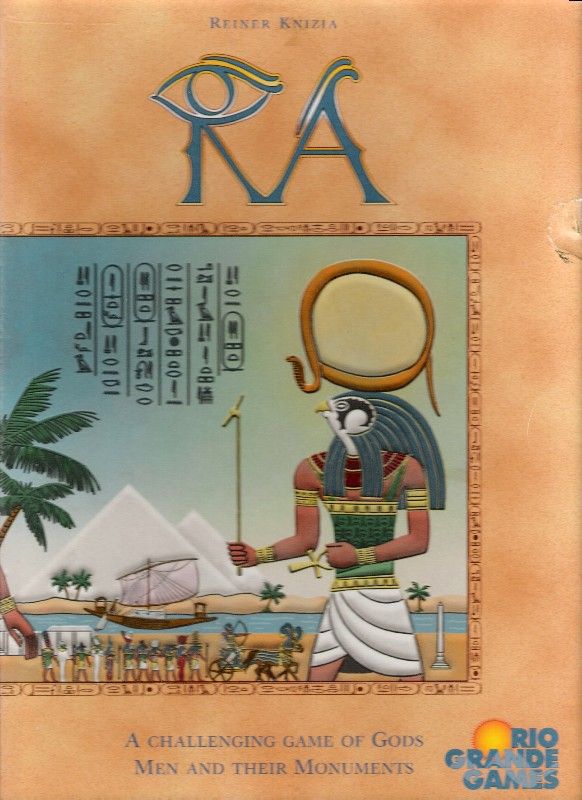
Firstly, the auctions are underpinned by risk-taking and greediness. You can only win three auctions during an epoch so you really want those lots to be worth it. But the contents of each lot emerge from the draw bag at random so is it worth ‘Invoking Ra’ to start an auction now – one where you have the final, potentially decisive bid – or should you wait longer to let that lot get tastier… or potentially worse if more Disaster tiles are drawn or the epoch ends because too many Ra tiles appear.
Next, when an auction does actually occur there’s no playing it safe: each player gets one chance to bid or pass and that’s it. The auctions themselves are tight and tense. Players need to be decisive, assessing in one moment what they think the lot is worth, what they think other players might think the lot is worth and what they can actually afford. You only have three Sun Disks with which to bid, only three times you can win anything – is it worth spending now on this lot or will there be far greater treasures just around the pyramid’s corner?
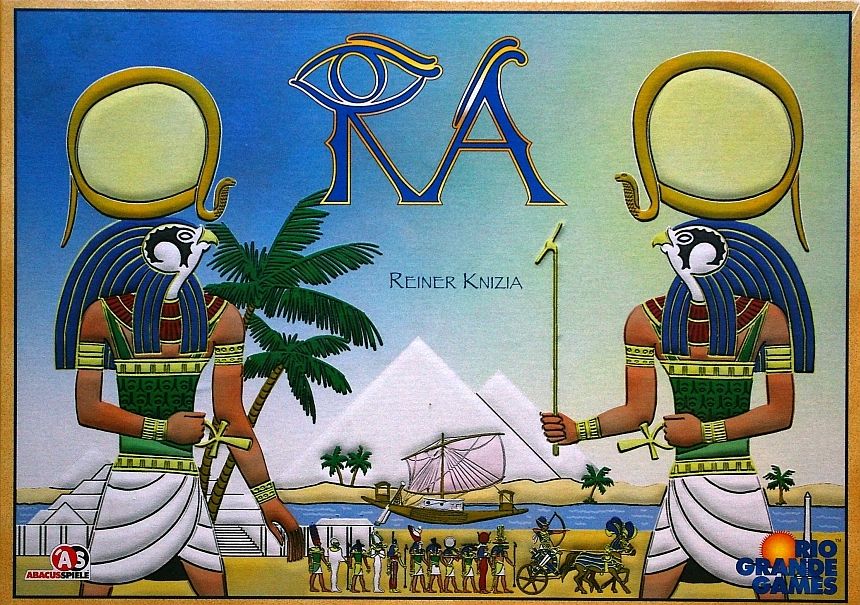
And since we’ve mentioned them, let’s finally cover what you’re bidding with, because it isn’t money. No, you’re spending Sun Disks which are… well, they’re never explicitly defined. Based on our reading of the rules and literature around Ra they represent the number of days you can spend doing what ma’at-tered* to ancient Egyptian rulers: improving the culture of Egypt, strengthening your lineage and respecting the gods before you mwt** your makers***.
*The word ‘ma’at’ (sometimes written as ‘maat’) was the ancient Egyptian concept of balance, truth, order, morality, justice and harmony of life, something that Egyptian rulers tried to preserve in their kingdoms. Maat was also the goddess who personified these concepts.
**The word ‘mwt’ is thought to be the ancient Egyptian for death or die, similar to the modern Egyptian/Arabic الموت (‘al-mawt’). The word ‘mwt’ was sometimes written as ‘mut’, which was the word for mother and also the name of the ancient Egyptian goddess Mut, the mother of everything in the world.
***The goddesses Ma’at and Mut were both daughters of Ra, deity of the sun, linking some silly linguistic wordplay back to our game of the moment and those Sun Disks.
Ahem, back to those Sun Disks. Each player starts the game with three or four of them, with one disk placed in the centre of the table. The disks are valued between 1 and 16, and if you’re successful in an auction you swap your winning bid with the disk in the middle, ready to use for auctions in the next epoch, or to be scored at the end of the game.
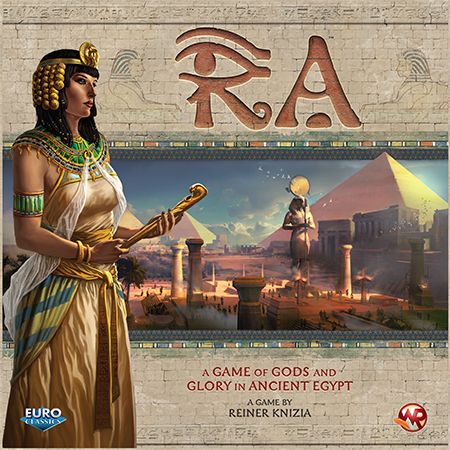
The result is a lovely interlocking system that keeps players on their toes throughout the game, balancing what tiles they want against the current and future value of those Sun Disks and the looming threat of the epoch ending without players using all their Disks. It’s also a rare auction game that works well at all player counts, including at 2 players, with Knizia insisting that he only wants his games to carry the player count ranges for which they play well.
Knizia has a keen interest in history and ancient Egypt in particular, as seen in the large number of his games set in the period. Indeed, 1993’s Tutankhamen (reimplemented in 2021 as Tutankhamun) was directly inspired by a trip to the Munich Museum of Egyptian Art and seeing a map of Egypt with historical civilisations clustered along the Nile. In fact, some have suggested that he has too many games set in ancient Egypt: he has often mentioned a case of an American publisher immediately passing on a game simply because they already had an Egyptian game!
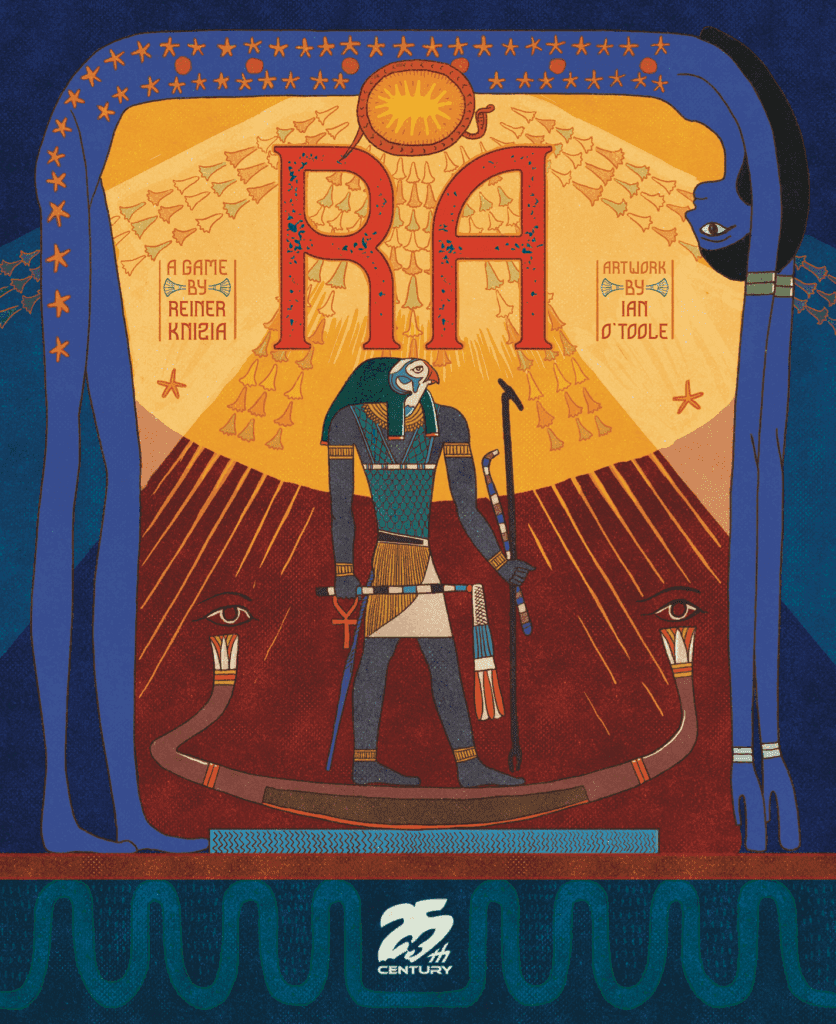
But Knizia also views history as having an important and useful commercial element when it comes to designing board games, as history can both inspire and communicate intent to players and prospective buyers. Knizia purposefully uses our ‘common understanding’ of history to help us understand what a game is about and our role in it, from the moment we see a new game on the shelf. We see pyramids on the cover and, without reading the back of the box, we automatically know a significant amount about the game inside and what types of individuals we might personify and behaviours we might be enacting.
Ra was Knizia’s first design after he quit his job in finance and took up board game design as a full-time career, five days after his 40th birthday (what a present to himself!). Purposefully deciding that he wanted to do an Egyptian game, Knizia started with an initial 3-hour long design with cards and a board, evolving it to be a pure board game, then a pure card game and finally adding a smaller board back in to become the design that we see today. All that time wasn’t wasted though, as Knizia reportedly revisited his original workings to create 2003’s Amun-Re.
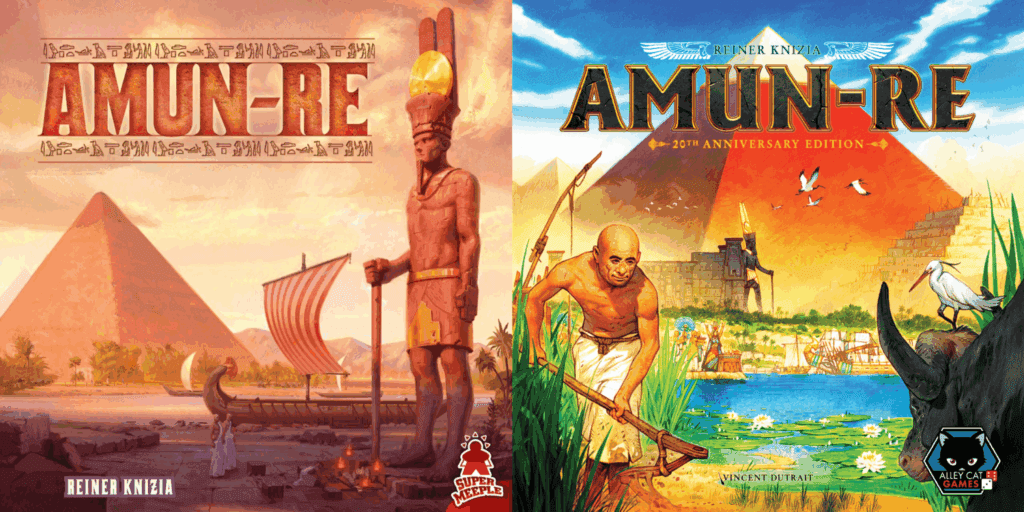
And look, we’ve been a little harsh on Amun-Re. As a game, it’s not trying to do the same thing as Ra or indeed as most of Knizia’s other auction designs. It’s one of Kniza’s most involved and complex games, featuring area control, auctions, resources and multiple phases per round. Whilst it’s not on the same scale of complexity as something like On Mars, it demonstrates that Knizia also excels at games with more rules. Meeple Mountain’s Justin Bell, no stranger to the complex gaming experience, describes Amun-Re as a “thrill ride” and an “approachable, deep design” in his 5-star review of Amun-Re: 20th Anniversary Edition.
It’s still not Ra though.
Indeed, Ra is so well respected that at the start of 2025 it was the tenth game to be inducted into the BoardGameGeek Hall of Fame. Following the induction of Tigris & Euphrates, Ra made Knizia one of only two designers to have two games in the first 25 inductees. The other designer is Francis Tresham who managed to inspire both the 18XX and tech-tree civ-building genres with his 1980s releases Civilization and 1830: Railways & Robber Barons. Knizia seems in good company there!
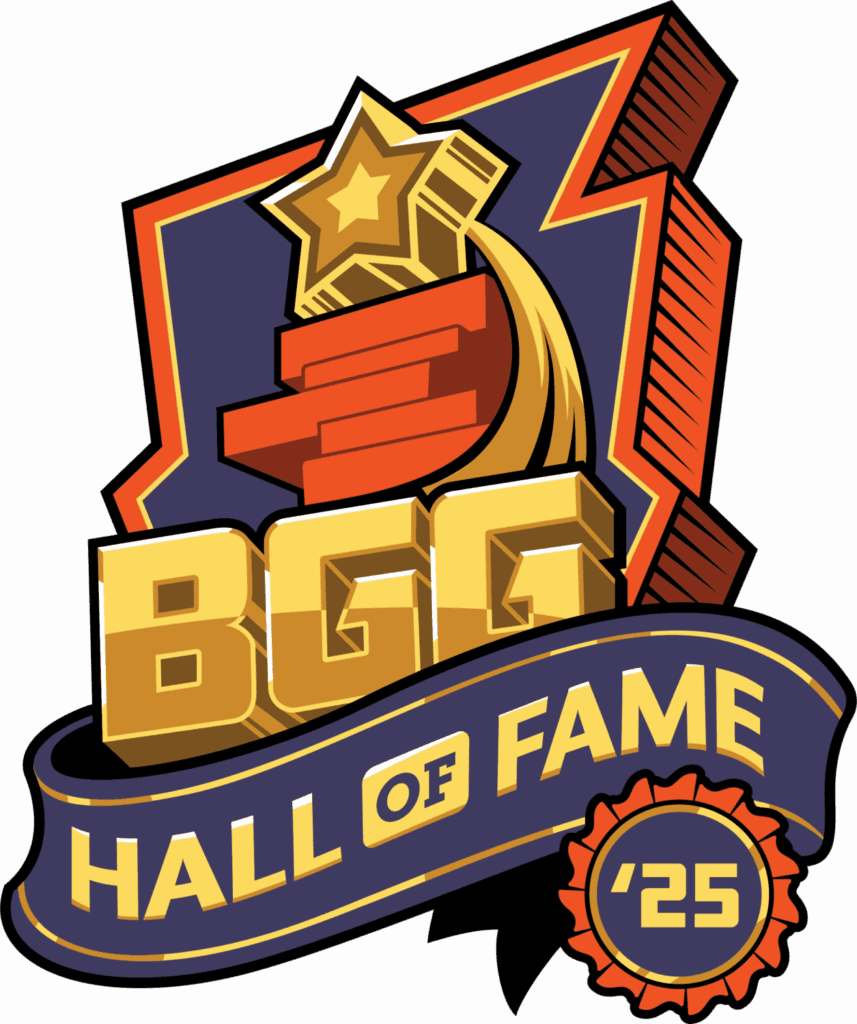
In the induction announcement, Grant Lyon (Grant’s Game Recs) stated that “Ra remains the best auction bidding game ever”, whilst designer Jamey Stegmaier (Stonemaier Games) said that it was his favourite of Knizia’s games: “it’s a testament to what set collection can be, what auctions can be and what push-your-luck elements of games can be, all combined into one really beautiful package… I think it’s really worth celebrating”. Meanwhile, Taylor Reiner (Taylor’s Trick-Taking Table) pointed out an often overlooked element of the design: “Every decision that Reiner made in this game is so smart, it is the pinnacle of game design to me. It is so fun, it is so funny, to have so much humour in the design, I don’t know how he did it, and to have so much math at the same time. I think we could all learn from Reiner Knizia.”
Beyond BoardGameGeek’s Hall of Fame, other respected tabletop commentators have also praised Ra. “The whole thing is really just a work of beauty,” said the Dice Tower’s Tom Vasel, listing it at number 4 of his ‘Top 10 Games I’ve Loved for a Long Time’ list, slightly ahead of Amun-Re at number 8. Nick Murray of Bitewing Games lists it at number 2 in his ‘Top 100 Board Games of All Time’ (just behind Knizia’s Tigris & Euphrates), saying that “Ra is a shining beacon of the [auction] genre” with a “smart set collection scoring system, inspired sun disk bidding system [and] the sizzling push-your-luck Ra timer”. Blake Michelle (Merry-Go-Round Magazine) echoes Murray’s thoughts, saying that Ra “weaves the two genres of auction and push-your-luck in a way that brings out the best aspects of both, with all the interesting value judgments and game theory of the former and each agonizing and tempting step in the latter.” Meanwhile, Shut Up and Sit Down placed Ra first equal in their stalled Top 100 Games of All Time series (alongside, or should that be inside, another Knizia game The Quest for El Do-Ra-do), saying that it’s an auction game that works even for those who don’t like auction games.
We could spend all day finding quotes from people who love Ra, but perhaps it’s best to leave the last word on the subject to Knizia himself: “it’s a very strong title”.
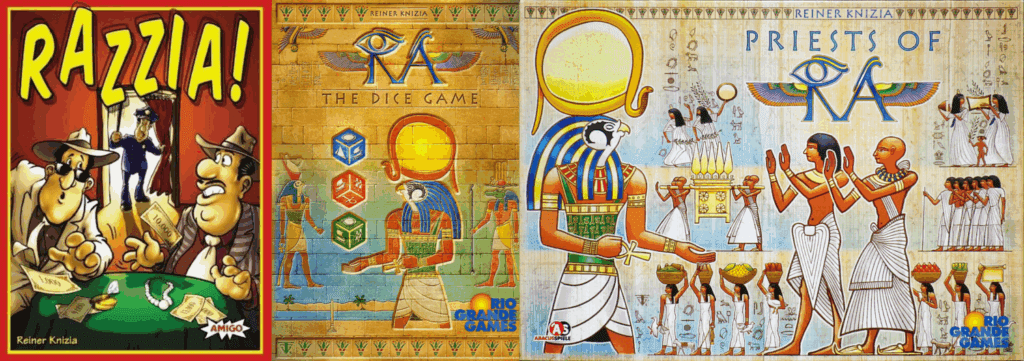
Ra is also a design framework that Knizia has returned to repeatedly. “I’m fascinated by the mechanisms of Ra,” he said on the 5 Games for Doomsday podcast, “because you’re not only bidding for the value of things you want to have but at the same time you are getting bidding power for the future.” The result of his ongoing interest is a family of games that has grown around Ra. The first was 2004’s Razzia!, a card game reimplementation that removes the disasters. Then came Ra: The Dice Game in 2009 which keeps much of the set collection but forgoes the auctions for Yahtzee-style dice rolling. The year 2009 also saw the release of Priests of Ra, which is a direct sequel to the original and uses the same auction mechanism but changes the set collection scoring categories and gives players the choice of how to use the double sided tiles they’re collecting.
Of course, the original Ra has seen a few new paint jobs too. Following the 1999 release (and 2008 edition using the same art), Ra was released in 2016 as part of the Z-Man Euro Classics Line, alongside Knizia’s Samurai, Through the Desert, Taj Mahal and Tigris & Euphrates. And in 2023 Ra received a decadent update from celebrated board game illustrator Ian O’Toole courtesy of 25th Century Games. It’s a match made in heaven, the classic elegance of their respective work complementing each other perfectly (see also Stephenson’s Rocket, Cascadero, Cascadito and the upcoming revised version of Rheinlander).
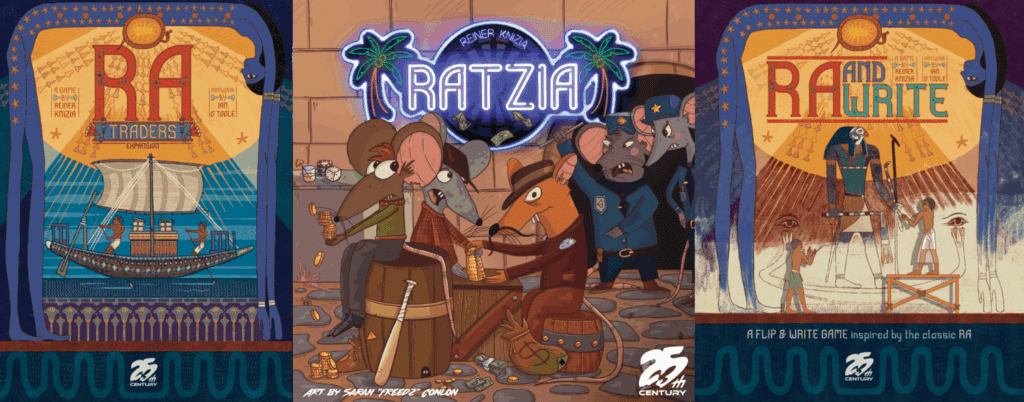
The collaboration between Knizia, O’Toole and 25th Century Games hasn’t ended there: this year sees the first ever expansion for Ra. Released over a quarter of a century after the base game, Ra: Traders adds a new tile type prompting even more interaction between the players. Released alongside the expansion are Ratzia (a revised edition of Razzia!) and Ra and Write, a spin-off in the flip-and-write genre. The coming months will also see crowdfunding for an updated version of Ra: The Dice Game (alongside the previously mentioned Rheinlander and a currently unknown third release).
These new and rereleased games are a testament to the original’s enduring popularity and for 25 years audiences have been discovering and rediscovering the power of invoking Ra.
Relishing Reiner’s Remaining Recreations
Ra ruled the ‘R’ roost, but there are reams of really respected runners up:
Rebirth – The newest design on this list, 2024’s Rebirth has been tickling the fancy of gamers all year with its clean design, bright colours and eco-friendly components. Whilst some complain that it’s ‘yet another Knizian tile-layer’, most people recognise that its easy rules, hidden depths and smooth gameplay make for an interesting and highly accessible entry into the genre.
Reif für die Insel – Ripe for the Island is a 2023 auction game where players are trying to gain bananas that are ripe that round, whilst avoiding under and overly ripe bananas and thieving parrots. It uses a clever bidding system (later recycled for 2024’s Conic) where players can bid zero and will always get their zero bid returned to them, even if it wins a bid. Despite being marketed towards the younger market, it showcases Knizia’s ability to make good games that work for all age groups. “Simple enough for children to play but rich enough for adults to enjoy,” says Meeple Mountain’s Andrew Lynch in his review of Reif für die Insel, “it’s another rock-solid entry in Reiner Knizia’s formidable roster of auction designs”.
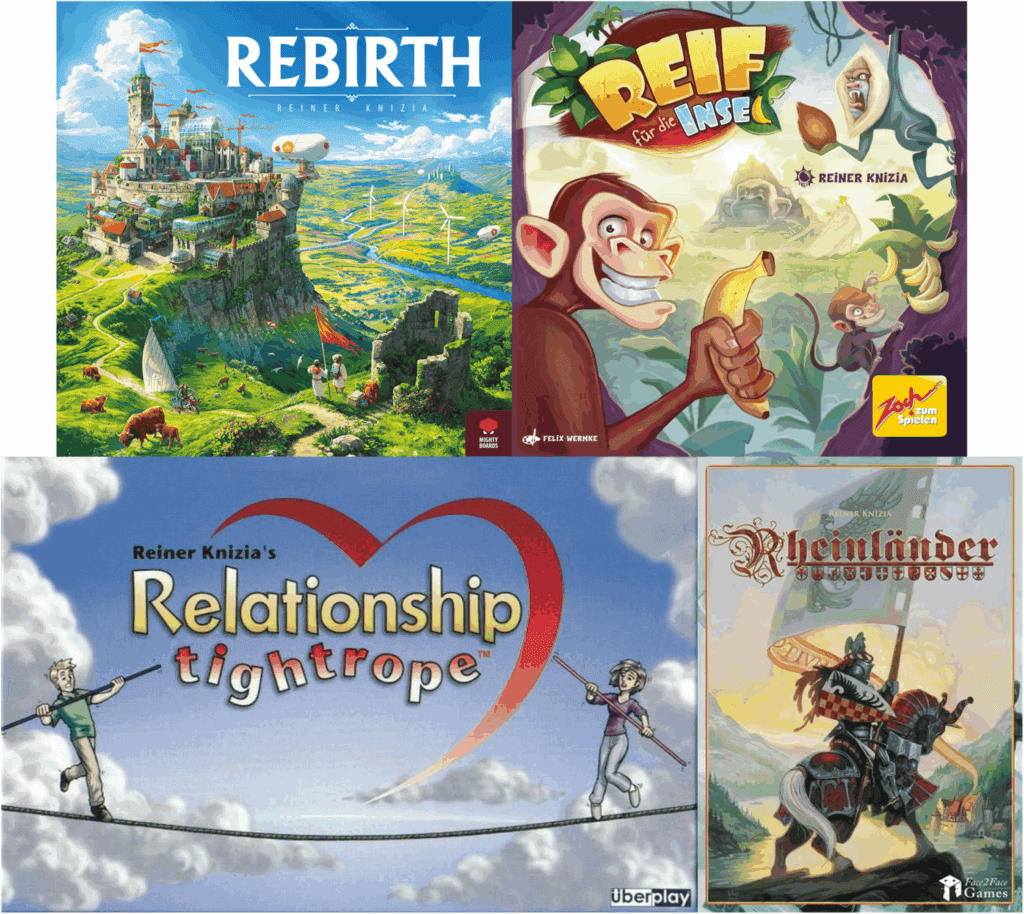
Relationship Tightrope – Released in the same year as our ‘R’ headliner Ra, Relationship Tightrope is a simple balancing act of give and take within a relationship. Each trick sees the players with the highest and lowest cards being ‘rewarded’ with blue or red sticks. These cancel each other out and the goal is to have the fewest left over sticks at the end of each round. Viewed today, the theme is slightly heteronormative – the sticks represent the ‘comical foibles of men (blue) and women (red)’ – but the gameplay remains cracking. We’d recommend searching out the 2021 rethemed version Odd Socks, which has a better theme and is super cute.
Rheinländer – Another great game released in 1999, Rheinländer is a game of area control and cardplay. Players vie to establish control of land along the banks of the Rhine River, gaining points and power by controlling cities, castles and churches. It’s a game of spotting opportunities and clever timing, with territories able to be snuck out from the grasp of other players. Somewhat underappreciated in the Knizia oeuvre, Rheinländer is receiving an updated edition via crowdfunding later this year courtesy of 25th Century Games.
Ribbit – Playable by children as young as five, 2004’s Ribbit is a surprisingly fun game for adults as well, all about frogs or tortoises racing and carrying one another on their backs. Players are assigned in secret a random frog/tortoise colour at the start and spend the race moving the different coloured frogs forward and back, with an individual at the bottom of a stack carrying all those on top of it when they move (similar to 2014’s Camel Up). The 2019 reimplementation Turtle Race Mini carries the same gameplay but loses the board to create a cute and very portable game for all ages.

Rondo – Released in 2012 and recommended for the Spiel des Jahres and the Golden Geek Best Abstract, Rondo is a game of placing numbered and coloured tokens on numbered and coloured spaces to score points. It’s a description that sounds deeply unexciting but rest assured there’s some interesting gameplay to be had, with players stretching to reach the right coloured and high scoring spaces on the board. In 2023 the game was reimplemented as Sunrise Lane by Horrible Guild with a few tweaks to the design and some excellent, if small and not especially colour-blind friend, production. “It’s punchy, it scales well for player count, and it’s easy to teach,” says Lynch in his review of Sunrise Lane, “it’s a solid choice for a family of mixed ages”.
Royal Visit – A tug-a-war game originally released as Times Square in 2006, Royal Visit sees the dueling players moving the location of various characters towards their end of the board. The aim is to get the king or the crown to visit your own chateau, by playing cards to move the various characters along the board or using the wizard and jester’s special abilities. Times Square was updated to Royal Visit in 2021 and is a very handsome production indeed.
–
And so ‘R’ is fully realised. What is your reaction to our rundown? Do you resolve to ridicule and roast our reviled register? Or do you recognise and respect our renowned reputation for first rate reasoning? How would you have ranked ‘R’? Regale us with your rating in the comments below and read the rest of the Reiner Knizia Alphabet here!


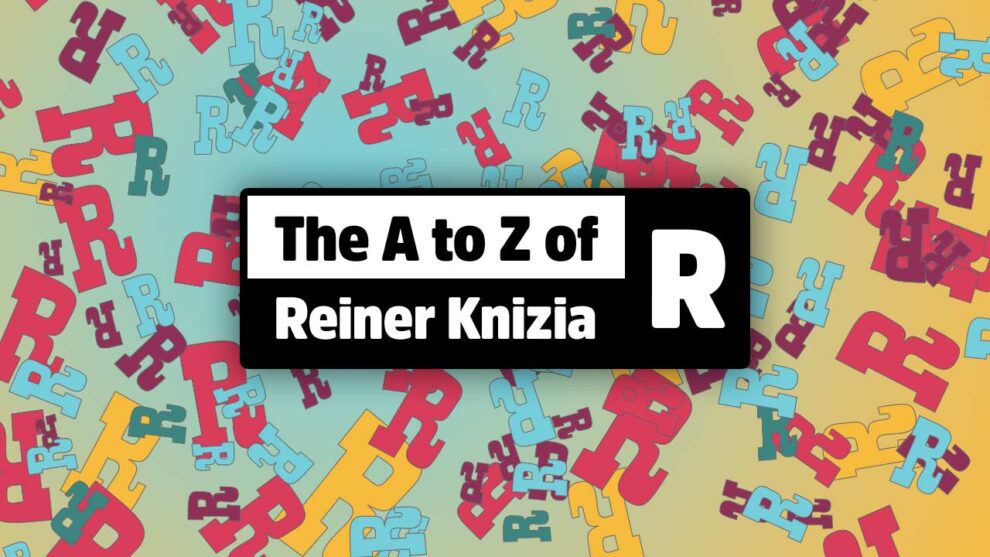





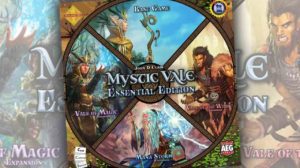
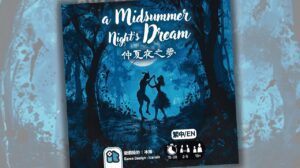



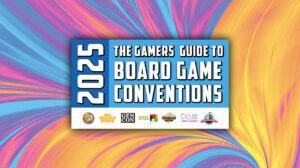

Add Comment